under construction - please be patient until Feb 17....
 Lin Yiyang's billiard hall in Helsin, with blue Nine Ball and green Snooker tables
Lin Yiyang's billiard hall in Helsin, with blue Nine Ball and green Snooker tables
Some people have expressed some frustration to have been "in the dark about the rules until the very last." wishing there had been "announcer voice overs explaining what's going on like they do for some sporting events." A part of them were bored by the repetition of the tournaments, despite the nice pictures of dexterity and precision and the interesting dress-code.
To this, MyeTezz reacted that "Just to provide another perspective as someone who enjoys playing snooker & pool. he felt that the filming and depiction of the sport were great. There were displays of high-level plays that were impressive, although I know that those without prior knowledge of the game might struggle to fully grasp the intricacies especially in terms of snooker. I actually liked how the screen time was perfectly allocated rather than an abundance of explanations or information about how the game works (which would be boring for me). After all, this series is more about the love story rather than serving as a tutorial or wiki on snooker/pool." Nevertheless he offered the following explanations, to which I researched some additions so we better grasp the technical details.
TABLES, CUES, BALLS AND POCKETS
These are standardized by large federations that keep and set the rules for the games.
The tables are rectangular with set dimensions and height, lined with rubber cushions, and for the games we are interested in, there are usually six pockets : one in each angle and one in the middle of each long side. The "bed" is usually made of very flat slate, covered by a fabric called baize, traditionally in green for snooker, but there are other colors possible. To the bottom of the table, a special area is divided according to what is called the "baulk" line, from which a half circle, called the "D" limits the area from which the breaking ball that opens the game will be played.
The balls are also of set dimensions, numbered or not, and in particular colors. Usually, the white ball is called the "cue ball"; when two players compete in English billiards, there's a second cue ball, usually yellow. The other, differently colored balls have a set place at the beginning of the game, on the "field" which is divided into areas. A group of balls (red ones, for snooker) will be "racked" (put together) in a diamond or pyramid shape. There will be other, differently colored, balls in particular spots. The one furthest from initial playing spot, near the "top cushion" is the "black", the spot at the tip of the pyramid is the "pink", and along the D touching the baulk line, These colored balls are "object balls" that must be moved by the "cue ball" hitting them", shot forward by the cue.
The Cues are made of wood, or fibreglass and are used for striking the balls. Their name goes back to the French "queue" (tail) because in the past, billiards were played with a sort of golf-club called mace, but the foot of the mace often got stuck under the cushions, so people started using them by the other end, until finally using plain tapered sticks. These cues are either stored at the billiards club, or can be folded in two or more sections, that can be carried in bags.
Chalk. The last essential piece of equipment is chalk. During the game, each player will chalk the end of their cue to ensure there is good contact between the cue and the ball. Chalk often comes in a small cube.
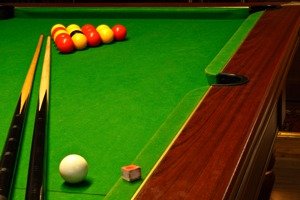
ENGLISH BILLIARDS
go back to the 16th century. They are played by two players (or teams of two) and use one object ball (red) and two cue balls (yellow and white). Each player uses a different color cue ball and attempts to score more points than their opponent and reach the previously agreed total required to win the match. The game is played on a table that has exactly the same dimensions (3569 mm x 1778 mm) as a snooker table, and in many places both games are played on the same table. Three balls must also be used, one red, one yellow and one white.
The players first, simultaneously, hit their cue ball the length of the table, hitting the cushion and returning back towards them. The player who gets their cue ball nearest to the baulk cushion at the end the shot was played gets to choose who breaks. The red ball is placed on the fieldand the player going first places their cue ball in the D and then plays the ball.
Players then take it in turn to attempt to score the most amount of points and eventually win the game. Players can score in three ways:
- In-off (2/3 points) : When the cue ball hits one of more balls and then goes down a pocket.
- Pot (23 points) /This is when any ball other than your cue ball goes into a pocket.
- Cannon (2 points) : This happens when the cue ball hits both other balls (2 points).
Players remain on the table until they fail to make a scoring shot.
Following a foul, the opposing player has the option of having the balls all put on their spots or leaving the table as it is.
The winner of the game is the first player to the points total that was declared the winning total before the game.
 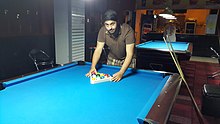 A player racking the balls (Wikipedia) A player racking the balls (Wikipedia)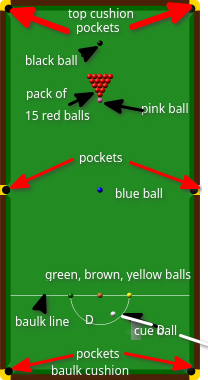 | SNOOKERMyeTezz explained : "In snooker, players must pot a red ball (1 pt) first before they can attempt to pot a colored ball, which carries varying point values (yellow-2, green-3, brown-4, blue-5, pink-6, black-7 pts). This alternation between potting reds and colored balls (red, colored, red, colored) continues until all the red balls are cleared from the table, after which players must pot the colored balls in sequence from yellow to black. To maximize their points, players need to strategically position the cue ball (white ball), ideally near the black ball (which yields the most points), after potting a red. They must also position for the next red ball after potting the black. Moreover, players will also need to deal with being "snookered," where their opponent skillfully blocks the path to the required ball, typically as fewer red balls remain on the table. Failing to hit the required ball results in a foul, with the opponent gaining points (a minimum of 4 pts, when you misses all the ball or hit any colored balls lower than 5 pts). Contacting let’s say a pink ball when you are supposed to hit a red ball will be a foul that gives the opponent the pink-ball points (6 pts), while for black it will give the opponent 7 pts, etc. The one with the most points at the end of the game wins (obviously). | ||
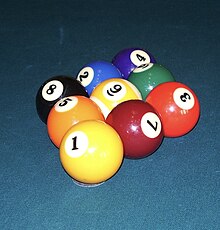 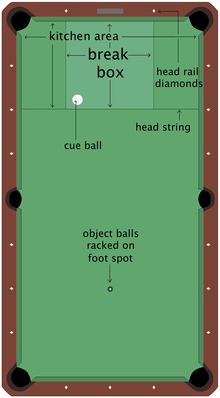 The break box used on the Euro Tour limits the areas in which a break can be played from. (Wikipedia) The break box used on the Euro Tour limits the areas in which a break can be played from. (Wikipedia) | NINE-BALL9-Balls origins are traceable to the 1920s in the United States.For 9-ball pool, it’s simpler, they just have to pot the balls numbered 1 through 9 in sequential order, starting from the lowest numbered ball first, the one who pot the 9-ball at any point wins the game (so hitting a required lowest numbered ball first but successfully potting the 9-ball in the process win instantly as well). |
Both game requires a lot of tactical positioning since you can’t just pot whichever ball you want and you must always plan for the next.
Recent Discussions
-
2024 52 Weeks Drama Challenge25 minutes ago - Mia
-
Which Was the Last Drama Episode You Watched? Part 326 minutes ago - hiphop123
-
Xiang Liu and You (Yes, You)31 minutes ago - atmospheres
-
Deng Wei - A Daily Picture Show37 minutes ago - Winny Aye
-
Last Drama You Completed? #21 hour ago - aad
Hottest Discussions
-
Change 1 letter to make a new word #26 hours ago
-
10 dramas/movies with ____? #411 minutes ago
-
Add and Subtract ( shuffle) new round7 hours ago
-
♥️Count to 7000000♥️49 minutes ago
-
Word Association #420 minutes ago
-
Which Was the Last Drama Episode You Watched? Part 326 minutes ago



